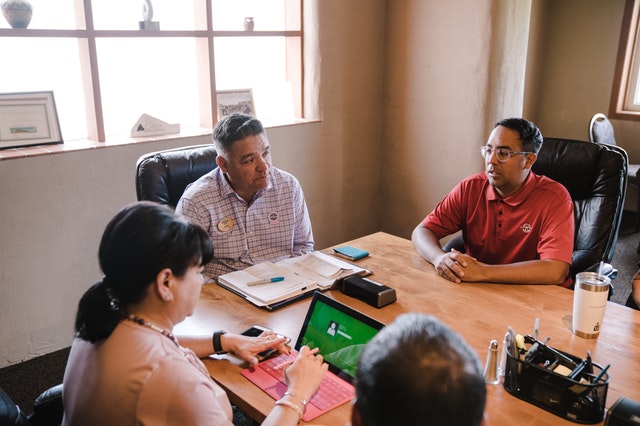When tension rises, the first thing we often do is talk. However, in reality, the solution isn’t found in speaking. We should instead be listening.
In workplaces where collaboration matters, active listening becomes the backbone of effective communication, conflict resolution, and team trust. Every employee can build active listening skills, and every team can benefit.
At Pollack Peacebuilding, we specialize in creating and conducting instructor-led conflict management training workshops and seminars, catering to employees across all hierarchies. Our programs include managers and executives, ensuring that your entire organization is quickly equipped to become skilled in active listening.
Definition and Significance of Active Listening in Workplace Peacebuilding
Active listening is a communication technique that requires the listener to feed back what they hear by restating or paraphrasing it in their own words, confirming that both parties have a shared understanding. Active listening techniques build clarity, foster trust, and help people feel heard. Being heard is a vital factor in workplace peacebuilding.
As Stephen R. Covey observed, “Most people do not listen with the intent to understand; they listen with the intent to reply.” This reactive habit often leads to disconnection, misunderstanding, and conflict.
When individuals shift toward actively listening, they can respond from a place of empathy rather than assumption.
Why Active Listening Requires Intention
Unlike passive listening, active listening skills require a conscious effort to be fully present. You should not be mentally scripting your reply while the other person is still speaking.
Instead, you should tune into their tone, notice nonverbal cues, and interpret the speaker’s facial expressions alongside their words. This level of attention strengthens understanding and minimizes communication gaps.
Active vs. Passive Listening
Passive listening is surface-level. You may nod, maintain eye contact, and appear attentive, but internally, you’re distracted. You hear the words but don’t absorb their meaning, often missing key points and emotional cues. This habit can lead to confusion, repeated instructions, or even frustration.
Active listening, on the other hand, involves a conscious effort to stay fully present mentally, emotionally, and physically. You paraphrase what you’ve heard, ask clarifying questions to check understanding, and provide feedback that proves you’re engaged.
While passive listening may seem harmless, it often creates distance and leaves others feeling dismissed. In contrast, active listening helps the person speaking feel respected, supported, and truly heard.
Why Listening Matters for Leaders
Teams look to leaders for direction as well as understanding. When leaders interrupt, dismiss, or assume, they risk creating distance and frustration.
Active listening bridges that gap. It promotes open communication and strengthens accountability, two areas often missing in environments with common weaknesses in leadership.
Leaders who practice active listening show their teams that they value input, consider multiple perspectives, and take time to understand concerns before making decisions. This approach encourages buy-in, reduces defensiveness, and improves decision-making.
Supporting Customer-Facing Roles
In addition to leaders benefiting from active listening skills, a customer-facing employee must also be an active listener. Key skills for customer service include the ability to listen, reflect concerns accurately, and ask the right open-ended questions. These frontline interactions often determine whether customers walk away satisfied or frustrated.
When service professionals focus on the speaker’s perspective, even in high-pressure situations, they create better experiences and minimize escalation.
Workplace Benefits of Active Listening
When people feel heard, they become more open, cooperative, and willing to engage. The benefits of active listening ripple throughout the organization.
Here’s how it contributes to peacebuilding and stronger team dynamics:
- Builds rapport and stronger relationships between coworkers and leadership
- Helps diffuse emotionally charged situations, which avoids behavior escalation
- Ensures professionalism in the workplace by promoting respectful dialogue
- Encourages a safe space for ideas, concerns, and constructive criticism
- Enhances problem-solving by allowing issues to be explored in full
- Improves psychological safety, trust, and retention
- Boosts social skills and emotional intelligence across teams
- Increases team-wide productivity and morale through better understanding
A Skill for All Contexts
One of the most powerful aspects of active listening is that it applies to both professional contexts and everyday life. Whether you’re handling conflict between departments or managing performance reviews, the same active listening techniques are transferable.
The ability to remain fully present, reflect the person’s feelings, and ask probing questions can transform even the most difficult conversations.
Active listening skills aren’t just for HR professionals or mediators. They’re for anyone who wants to strengthen collaboration and reduce friction, making them essential in personal and professional contexts alike.
Steps and Techniques of Active Listening
Becoming a better listener is not just about being quiet while someone else speaks. It involves applying specific active listening techniques that enhance clarity, foster mutual understanding, and promote effective communication.
Below are foundational skills to practice active listening, each designed to deepen the conversation and prevent conflict.
Restate – Confirming the Facts
Restating means repeating what the speaker said using nearly identical wording. Restating aims to confirm that you’ve captured the basic facts correctly before moving forward.
Active listening skills ensure that you and the person speaking are aligned from the start. It prevents misinterpretation and shows that you’re giving your full attention.
Example:
Speaker: “I was left off the client email, and I had no idea the meeting time changed.”
Active listener: “You’re saying you didn’t get the email and missed the new meeting time?”
Active listening requires this simple technique to keep misunderstandings from snowballing.

Paraphrase – Reflecting the Meaning
When you are paraphrasing, you are rewording what you heard to reflect the speaker’s intent. Paraphrasing often begins with phrases like “So what I’m hearing is…” or “You’re saying that…”
Paraphrasing matters because it shows that you’re actively listening and attempting to understand the message beyond the surface. It also gives the speaker a chance to correct any misinterpretations.
Example:
“You’re saying you felt unsupported when the decision was made without your input?”
These active listening skills are especially useful when emotions are involved. It slows down the conversation and allows both sides to recalibrate.
Summarize – Reiterating Key Points and Emotions
Summarizing condenses the key points and reflects both facts and feelings. Unlike paraphrasing, which happens mid-conversation, summarizing often comes toward the end.
Summarizing demonstrates comprehension and signals closure or transition. It also helps the other party feel heard and validated.
Example:
“So to recap: You felt overwhelmed, unsupported, and left out of key decisions, which made the project more stressful than it needed to be.”
This active listening technique ensures nothing is missed and keeps communication clear.
Reflect – Acknowledging the Speaker’s Feelings
When reflecting, you should tune into and name the person’s feelings, often based on their tone, body language, or emotional cues.
Why it matters:
Many people don’t feel fully heard unless their emotions are acknowledged. Reflecting emotions creates a safe space and allows the speaker to move from emotional expression to problem solving.
Example:
“It sounds like you’re feeling frustrated and underappreciated.”
In the example above, you’re not offering solutions yet. You’re helping the speaker explore and articulate what’s really going on.
Reframe – Shifting the Narrative
Reframing turns negative, blaming, or vague language into something constructive. It helps move the conversation toward resolution by focusing on underlying needs instead of accusations.
Why it matters:
When conflict flares, people often speak in absolutes. Reframing replaces judgment with clarity and reduces emotional heat.
Example:
Original: “I’m tired of doing all the work myself.”
Reframed: “It sounds like you’d like more shared responsibility on this project.”
These active listening skills help keep the communication process constructive, especially when delivering bad news or mediating heated discussions.
Validate – Showing Appreciation and Empathy
Validation involves acknowledging the speaker’s effort, emotions, or experience. It doesn’t require agreement, just recognition.
Why it matters:
Validation promotes trust and empathy. It tells the speaker that their feelings are legitimate and their voice matters.
Example:
“Thanks for sharing this. I can see this situation really impacted you.”
This is especially powerful in moments of vulnerability and conflict. It shows that you’re listening and fostering understanding.
Definition List Recap of Techniques
- Restate: Repeat the facts to confirm accuracy
- Paraphrase: Reword to reflect the speaker’s meaning
- Summarize: Condense key facts and feelings
- Reflect: Name the emotions being expressed
- Reframe: Shift language to be more constructive
- Validate: Acknowledge the speaker’s effort and emotions
All of these techniques are part of a larger active listening framework. This framework works in meetings, performance reviews, team conflicts, and client conversations alike. Whether in professional contexts or personal ones, these skills help create more thoughtful, respectful, and productive dialogue.
Challenges Overcome by Effective Active Listening
Active listening skills are powerful, but they don’t always come naturally. There are numerous barriers that can block our ability to fully engage in conversation. These range from environmental distractions to internal biases.
Let’s explore some of the most common obstacles and how to overcome them.
Common Barriers to Listening
- Physical and Environmental Barriers: Loud noise, poor lighting, or uncomfortable spaces can make it hard to pay attention. Additionally, visual clutter and interruptions can fragment focus, even if you’re trying to listen.
- Internal Distractions: Mental rehearsing, daydreaming, and multitasking reduce your ability to stay fully present. It’s common to start planning your reply before the speaker’s words have even landed.
- Emotional Barriers: Strong emotions like anger, anxiety, or defensiveness block empathic listening. When you feel attacked or overwhelmed, you cannot process what’s being said objectively.
- Cognitive Biases: Prejudgments or assumptions about the speaker distort the message. You may think you know what’s coming and tune out, missing nuance or intent.
- Cultural and Language Barriers: Differences in tone, idioms, or gestures may lead to misunderstanding. Misinterpretation happens easily when our own thoughts overpower curiosity.
How to Overcome These Barriers
To counter these challenges, try these strategies:
- Create a Distraction-Free Environment: Choose quiet, well-lit spaces. Silence your phone and close other tabs. A calm setting improves focus and signals respect.
- Practice Mindfulness: Take a few deep breaths before engaging. Ground yourself by noticing facial expressions or tone changes. You can also use techniques like note-taking to stay in the moment.
- Label and Manage Emotions: Recognize when you’re frustrated or distracted. If needed, ask for a break to regain composure. Use empathy to see the issue from the other party’s perspective.
- Challenge Your Biases: Ask yourself, “Am I jumping to conclusions?” Use clarifying questions like, “Can you say more about that?” or “What do you mean by that?”
- Simplify Language and Ask for Clarification: Avoid jargon or cultural slang. If you don’t understand, say, “Could you rephrase that?” These small steps promote better understanding and connection.
These adjustments make you a more effective listener—one who’s engaged, adaptable, and ready to respond rather than react.
The Role of Active Listening in Resolving Conflicts and Fostering Peace
When workplace tensions rise, most people rush to fix the problem or defend their position. However, conflict doesn’t get solved through quick reactions. It gets solved through deeper understanding, and that starts with active listening.
When employees and leaders alike slow down, tune in, and acknowledge what’s really being said, they transform disagreements into opportunities for growth.
One of the most effective tools in active listening techniques is emotional labeling. This involves naming the emotion you observe in the speaker to help reduce its intensity. This powerful de-escalation tactic supports empathy without taking sides.
Real-World Example: A Conversation That Could’ve Gone Wrong
Let’s look at how a manager used active listening to navigate a tense conversation and reach a peaceful resolution.
Employee: “Hi James, do you have a minute? I just got my paycheck and noticed it’s $400 less than usual. Was there a mistake?”
Manager (puts down phone, closes laptop, maintains eye contact): “Yes, of course. I’m glad you came to me. Tell me more about what you noticed.”
Employee: “I wasn’t told anything about a deduction. It feels like this came out of nowhere.”
Manager (pauses, reflects): “It sounds like you’re confused and frustrated. I can see why—it’s never easy to find out about a pay change unexpectedly.”
Employee: “Exactly. I’ve been meeting deadlines and thought everything was fine.”
Manager (summarizes): “So, you’re saying you weren’t aware of any reason for a deduction and felt caught off guard.”
Employee: “Yes. I wish I had known in advance.”
Manager (reframes): “Sounds like what you’re really asking for is more transparency so you can feel more in control of your work and compensation.”
The manager then clarified the deduction, acknowledged the lack of communication, and promised reimbursement along with a review of the process. A moment that could have escalated into resentment became a conversation rooted in trust.
How Active Listening Prevents Escalation
The interaction above exemplifies how active listening helps calm emotions and create space for mutual understanding. When applied intentionally, it can:
- Reduce tension by allowing both sides to feel heard
- De-escalate anger by labeling emotions and validating experiences
- Shift the conversation from blame to problem-solving
These outcomes are especially important in environments where miscommunication often triggers bigger problems. Learning to respond rather than react is a core element of workplace peace.
Supporting All Types of Conflict Resolution
Whether it’s a clash of personalities, misaligned expectations, or a breakdown in communication, active listening is the thread that connects people back to shared goals. It supports every aspect of conflict management.
For instance, it directly helps all types of conflict, from employee disputes to leadership disagreements.
Promoting Empathy and Professionalism
Beyond just resolving the moment, active listening builds a culture of respect. When someone uses open-ended questions and nonverbal cues to stay fully engaged, it’s easier for others to trust their intent.
This approach naturally supports professionalism by modeling how to manage stress with maturity and integrity. Over time, it creates a team culture where everyone is accountable, not just for results but for how they communicate.
Finally, conflict resolution in the workplace improves the safety of everyone within the premises. For example, practicing active listening techniques in healthcare settings greatly reduces instances of medical errors while preventing unintentional harm that could befall patients.
Empower Your Team Through Better Listening
At Pollack Peacebuilding, we believe active listening is a pathway to healthier workplace relationships, better collaboration, and long-term peace.
It’s also something every team member can learn.
Through our interactive, instructor-led conflict resolution workshops, we teach professionals across all levels how to practice active listening in real-world scenarios. Whether you’re managing direct reports, navigating peer feedback, or handling difficult customers, these sessions offer tools that apply immediately.
Our training includes:
- Practical frameworks and active listening techniques for teams
- Role-playing to strengthen active listening listening skills and build empathy
- Custom strategies for reducing behavior escalation and boosting open communication
- Coaching that improves problem solving, professionalism, and team trust
Most importantly, our programs meet employees where they are. They’re relevant, actionable, and tailored to your organizational goals.
If you’re ready to help your team feel heard, understood, and empowered, we’re here to help you make it happen. Join us in our journey toward better communication and conflict resolution.



